Daily ridership 390,600 (Q4 2014) Number of vehicles 298 | Annual ridership 137.4 million (2016) Began operation December 11, 1985 Transit type Rapid transit Number of lines 3 | |
 | ||
Locale Greater Vancouver, British Columbia, Canada Operator(s) British Columbia Rapid Transit Company(Expo and Millennium Line)Protrans BC (Canada Line) Character Underground, at-grade, and elevated | ||
SkyTrain is the metropolitan rail system of Greater Vancouver, British Columbia, Canada. SkyTrain has 79.5 km (49.4 mi) of track and uses fully automated trains on grade-separated tracks running on underground and elevated guideways, allowing SkyTrain to hold consistently high on-time reliability. The name, SkyTrain, was coined for the system during Expo 86 because the first line (Expo) principally runs on elevated guideway outside of Downtown Vancouver, providing panoramic views of the metropolitan area. SkyTrain has the world's longest cable-supported transit-only bridge, known as SkyBridge, to cross the Fraser River in the suburbs. The opening of the Evergreen Extension on December 2, 2016, made SkyTrain the longest rapid transit system in Canada and the longest fully automated driverless system in the world.
Contents
- Expo Line
- Millennium Line
- Canada Line
- Operations
- Frequency
- Fares
- Fare gates Compass card
- Fares in the Airport Zone
- Ridership
- Funding
- Security
- Planning
- Impact
- Design
- Expo and Millennium Lines
- Future expansion
- UBC LineBroadway corridor extension
- Expo Line extension
- Expo Line capacity expansion
- References
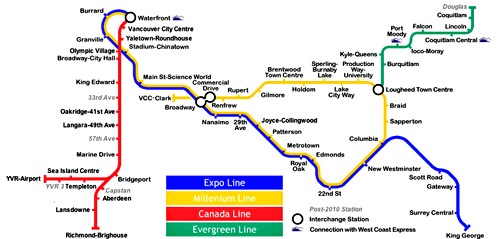
SkyTrain has 53 stations serving three lines: the Expo, Millennium, and Canada Lines. The Expo Line and Millennium Line are operated by British Columbia Rapid Transit Company under contract from TransLink (originally BC Transit), a regional government transportation agency. The Canada Line is operated on the same principles by the private concessionaire ProTrans BC under contract to TransLink, and is an integrated part of the regional transport system. SkyTrain uses a fare system shared with other local transit services, and is policed by the South Coast British Columbia Transportation Authority Police Service. SkyTrain Attendants (STAs) provide first aid, directions and customer service, inspect fares, monitor train faults, and operate the trains manually if necessary.
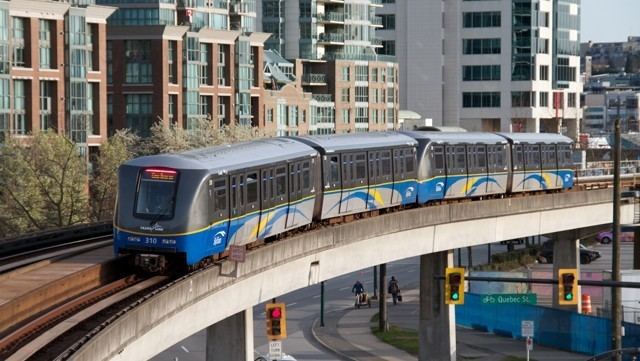
Expo Line
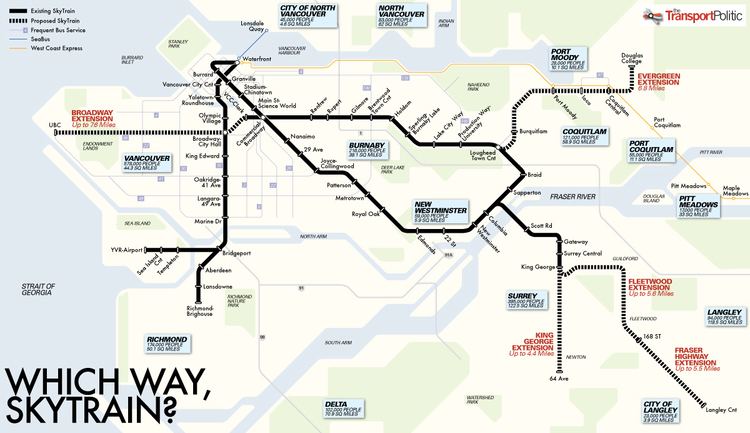
The Expo Line connects Waterfront Station in Vancouver to King George Station in Surrey, principally along a route established by the Westminster and Vancouver Tramway Company as an interurban line in 1890. The Expo Line (originally referred to as simply "SkyTrain" until the opening of the Millennium Line) was built in 1985 in time for Expo 86. It now has 24 stations. The Expo Line ran only as far as New Westminster Station initially. In 1989, it was extended to Columbia Station and in 1990, once the Skybridge was finished, it continued across the Fraser River to Scott Road Station in Surrey. In 1994, the terminus of the Expo line became King George Station in central Surrey. It was built on a budget of $854 million (1986 dollars). Effective October 22, 2016, Expo Line trains began operating on a new branch to Production Way-University, taking over the previous Millennium Line service between Waterfront and Production Way–University. During peak periods, every third Expo Line train provides service to Production Way–University; off-peak, trains alternate between the two branches.
Millennium Line
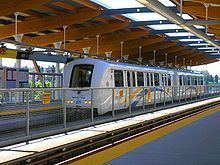
Prior to October 22, 2016, the Millennium Line shared tracks with the Expo Line from Waterfront Station to Columbia Station in New Westminster, then continued along its own elevated route through North Burnaby and East Vancouver, ending at VCC–Clark Station, near Vancouver Community College's Broadway campus. It was built on a $1.2-billion budget and the final extension from Commercial Drive Station to VCC–Clark Station was opened on January 6, 2006. From October 22, 2016 to December 1, 2016, the Millennium Line operated from VCC–Clark to Lougheed Town Centre station. Since December 2, 2016, the Millennium Line has operated between VCC–Clark Station in Vancouver and Lafarge Lake–Douglas station in Coquitlam. The Millennium Line has 17 stations, three of which are transfer stations with the Expo Line (Commercial–Broadway, Production Way–University, and Lougheed Town Centre) and two which connect with the West Coast Express commuter train (Moody Centre and Coquitlam Central). The original Millennium Line's stations were designed by British Columbia's top architects and are very different from those on the Expo Line. In 2004, Busby and Associates Architects, designers of the Brentwood Town Centre station in Burnaby, were honoured for their work with a Governor General's Medal in Architecture.
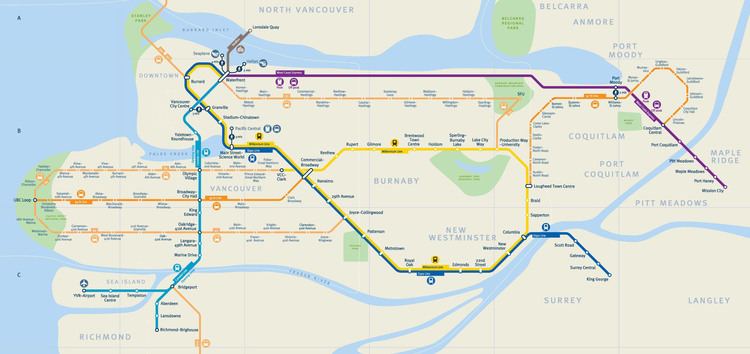
Construction on the Millennium Line's Evergreen Extension, from Lougheed Town Centre in Burnaby to Lafarge Lake–Douglas in Coquitlam, completed in 2016 and the extension was opened for revenue service on December 2, 2016. This extension adds 11 km (6.8 mi) and 6 new stations to the Millennium Line.
Canada Line
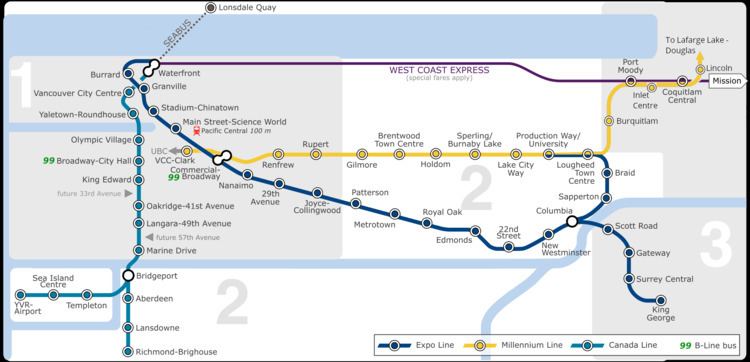
The Canada Line begins at the Waterfront Station hub, then continues south to the City of Richmond and Sea Island. From Bridgeport Station, the Canada Line splits into two branches, one heading west to the YVR–Airport Station at Vancouver International Airport and the other continuing south to the Richmond–Brighouse Station in Richmond's city centre. Opened on August 17, 2009, the Canada Line added 15 stations and 19.2 km (11.9 mi) to the SkyTrain network. Waterfront Station is the only station where the Canada Line directly connects with the Expo Line and Millennium Line; however, Vancouver City Centre Station is within a three-minute walk from Granville Station via the Pacific Centre mall, making an unofficial transfer to the Expo Line. The Canada Line cost $1.9 billion, financed by the Governments of Canada and British Columbia, TransLink, and InTransitBC. The Canada Line's trains, built by Rotem, are fully automated, but are of a different design from the Expo and Millennium lines' Bombardier-built fleet, and use conventional electric motors rather than linear induction motor technology. Canada Line tracks do not interconnect with the older SkyTrain network, and there is a separate fleet maintenance depot.
Operations
Current operation:
Former operation (prior to October 22, 2016):
Frequency
SkyTrain provides high-frequency service, with trains arriving every 2–7 minutes at all stations during peak hours. Trains operate between 5:00 a.m. and 1:30 a.m. on weekdays, with reduced hours on weekends on Expo and Millennium lines. SkyTrain has longer hours of service during special events, such as New Year's Eve, the Vancouver 2010 Olympics, and marathons.
Fares
TransLink's SkyTrain service area is divided into three zones, with fares varying depending on how many zone boundaries are crossed during one trip (two- and three-zone passengers are charged the one zone rate after 6:30 pm rush hour, and on weekends and statutory holidays). Customers may purchase fares using cash, debit cards, or credit cards from self-serve ticket vending machines at the mezzanine level of each station. A variety of transit passes are available, such as the pre-paid FareSaver ticket, daily DayPass, monthly FareCard, annual EmployerPass, post-secondary student U-Pass, and other specialized passes. Canadian National Institute for the Blind identification cards are accepted without the need to be read by the fare box. One-time fares are valid for 90 minutes on any mode of transportation with any number of transfers, including all SkyTrain lines and bus and SeaBus routes. Concession fares are available for children (ages 6–13), secondary school students with a valid Go-Card and the elderly.
Until April 2016, SkyTrain's fare system was a proof-of-payment system; there were no turnstiles at the entrances to train platforms. Instead, fares were enforced by random ticket inspections – usually by police or transit security but occasionally by SkyTrain attendants – through trains and stations, or at special events such as after BC Lions or Vancouver Canucks games. The fine for failure to show proof of payment, fare evasion, ticket reselling, or other scams is $173.
Fare gates (Compass card)
Installing faregates to prevent fare evasion was considered, but was rejected because the expense of implementing, maintaining, and enforcing them would exceed the losses prevented. In 2005, TransLink estimated it was losing $4 million (5% of revenue attributed to SkyTrain) annually to fare evasion on SkyTrain. The Canada Line opened in 2009 without fare gates, despite stated intentions to include them. The Canada Line and Millennium Line stations were designed to allow for future fare gates. Expo Line stations are being redesigned and retrofitted to accommodate the new fare gate system.
The 2008 Provincial Transit Plan outlined several SkyTrain system upgrades, including replacement of the proof-of-payment system with a gated-ticket system. According to then-Minister of Transportation Kevin Falcon, the gated-ticket system would be implemented by a private company by 2010. In April 2009 it was announced that the provincial and federal governments would spend $100 million to put the gates in place by the end of 2010. However, in August 2009 a TransLink spokesman said the gates would not be installed before 2012, and that a smart card system would be implemented at the same time.
It was announced on August 14, 2013, that bus transfer system (magnetic strip paper cards) would continue to be used for cash fares, and bus to bus transfers, but would not work at the turnstiles at train stations, which will require a Compass (RFID) card. This means that a bus rider paying cash would be required to buy an additional ticket to transfer to a train.
Construction of SkyTrain fare gates was completed in May 2014, however, as of March 2016 TransLink announced that the fare gates would be closing in April of that year during peak hours and one gate remaining open during off-peak times for disabled people, who cannot open the gates with their hands. The approximately 85,000 users who hold a Compass Card are expected to tap in and tap out as they pass through the gates. Holders of paper tickets and FareSaver tickets continue to pass through the gates into the fare paid zone unimpeded, although they are subject to having their fare inspected by transit security or transit police once inside the fare paid zone. Full implementation of the fare gates continues to be delayed by ongoing problems with the Compass Card when riders are tapping out as they exit transit buses. The tapping out process on buses is too slow and doesn't always record the tap which can result in the customer being charged for travelling through three zones when in fact they only travelled through one or two zones. This has been a serious setback for TransLink as the entire system was supposed to be operational by 2013. TransLink did not give a date for when the fare gates would begin full operation, but stated that the fare gates would remain open until the Compass system is in full operation.
Fares in the Airport Zone
Travel on the Canada Line is free between the three Sea Island stations near the airport: Templeton, Sea Island Centre, and YVR–Airport.
Cash fares (single-use Compass tickets) purchased at ticket machines in stations on Sea Island include an AddFare of $5.00 on top of the normal fare. This charge is also added to trips initiated on Sea Island that travel east beyond Sea Island using Compass Card Stored Value or DayPasses. It is not applied to trips using monthly passes, nor to trips using DayPasses or single-use Compass tickets which were activated outside the Airport Zone. The AddFare came into effect on January 18, 2010. The revenue collected from the AddFare goes back to TransLink.
Ridership
Passengers on SkyTrain made an average of 390,600 trips on weekdays during the third quarter of 2014. In 2014, the network carried a total of 117.7 million passengers. This compares to 117.4 million passengers in 2010: 38,447,725 on the Canada Line and 78,965,214 on the interlined Expo and Millennium Lines. The Canada Line carried an average of 110,000 passengers per weekday in early 2011, and is three years ahead of ridership forecasts.
SkyTrain's highest ridership came during the 2010 Winter Olympics when each event ticket included unlimited day-of transit usage. During the 17-day event, Canada Line ridership rose 110 per cent to an average of 228,000 per day, with a single-day record of 287,400 on February 19, 2010. Expo and Millennium Line ridership rose 64 per cent to an average of 394,000 per day, with a single-day record of 567,000 on February 20, 2010. At times, every available train was in service on all three lines. After the Olympics ended, overall transit usage remained 7.8 percent above the previous year.
Funding
The cost of operating SkyTrain in 2008, with an estimated 73.5 million boardings, was $83 million. To cover this, TransLink draws mostly from transit fares, advertising ($360 million in 2008) and tax ($262 million from fuel taxes and $298 million from property taxes in 2008), funds which are also shared with bus services, roads and bridge maintenance, and other infrastructure and services. The capital costs of building the system are shared with other government agencies. Capital expenses were $216 million in 2008. For example, the cost of building the Canada Line was shared between TransLink ($335 million or 22 percent), the federal government (29 percent), the provincial government (28 percent), the airport authority (19 percent), and the City of Vancouver (2 percent). While TransLink has run surpluses for operating costs since 2001, it incurs debt to cover these capital costs. As a whole, TransLink had $1.1 billion in long-term debt, in 2006, of which $508 million was transferred from the province in 1999 when responsibility for SkyTrain was given to TransLink. The province retained ownership of the causeway, bridge, certain services, and a portion of SkyTrain's debt.
Security
Law enforcement services are provided by the South Coast British Columbia Transportation Authority Police Service (SCBCTAPS), formerly the Greater Vancouver Transportation Authority Police Service (GVTAPS). They replaced the old TransLink Special Provincial Constables, who had limited authority.
On December 4, 2005, GVTAPS officers became the first and only transit police force in Canada to have full police powers and carry firearms. There was public concern in March 2005 when it was announced that transit police would carry firearms. Then-Solicitor General of British Columbia John Les defended the move, saying that it was necessary to enhance SkyTrain security. Transit officers receive the same training as officers in municipal and RCMP forces. They may arrest people for outstanding warrants, enforce drug laws, enforce the criminal code beyond TransLink property, and deal with offences that begin off TransLink property and make their way onto it. They issue tickets for fare evasion and other infractions on SkyTrain, transit buses, SeaBus, and West Coast Express.
Transit police officers and Transit Security personnel inspect fares at Skytrain stations as part of TransLink's Fare Audit. Transit Security mostly focus their efforts on the bus system, bus loops, and SeaBus. As of September 2012, Transit Security Officers have the authority to issue tickets for Fare Evasion.
SkyTrain Attendants provide customer service and first aid, troubleshoot train and station operations, and perform fare checks alongside the transit police force. SkyTrain Attendants can be identified by their uniforms which say "SkyTrain" on them.
Over the years, violence and other criminal activities have been concerns, but TransLink insists the system is safe. Then-Inspector Kash Heed of the Vancouver Police Department says that little crime takes place in the stations themselves. However, criminal activity becomes more visible 400–700 metres (1,000–2,000 ft) outside them.
Each station is monitored with an average of 23 closed-circuit television cameras, allowing SkyTrain operators to monitor passenger and station activity. Designated wait areas have enhanced lighting, waiting benches, and emergency telephones. Trains have yellow strips above each window which, when pressed, silently alert operators of a security hazard. On-board speaker phones provide two-way communication between passengers and control operators.
In 2007, it was reported that the entire surveillance system was upgraded from analogue two-hour tape recording to digital technology, which was to allow police to retrieve previous footage for up to seven days. However, incidents since the upgrade have still limited police to a two-hour loop, resulting in loss of potential evidence.
By November 2008, at least 54 deaths had occurred on the platforms and tracks of the Expo and Millennium Lines. 44 of those deaths were suicides, while the remaining ten were accidental.
Planning
Vancouver had plans as early as the 1950s to build a monorail system, with modernist architect Wells Coates to design it; that project was abandoned. The lack of a rapid transit system was said to be the cause of traffic problems in the 1970s, and the municipal government could not fund the construction of such a system. During the same period, Urban Transportation Development Corporation, then an Ontario crown corporation, was developing a new rapid transit technology known as an "Intermediate Capacity Transit System". In 1980 the need for rapid transit was great, and Ontario needed buyers for its new technology. "Advanced Rapid Transit" was selected to be built in Vancouver to showcase the Ontario project at Expo 86.
Expo Line
SkyTrain was conceived as a legacy project of Expo 86 and the first line was finished in time to showcase the fair's theme: "Transportation and Communication: World in Motion – World in Touch". Construction was funded by the provincial and federal governments. It was built through the Dunsmuir Tunnel under downtown, which had originally been built for the Canadian Pacific Railway.
Until 1989, SkyTrain terminated at New Westminster Station; in 1987 construction began on an extension including the Skybridge, Columbia Station, and Scott Road Station, extending service to Surrey. The line was expanded again in 1994 with the opening of the Gateway, Surrey Central, and King George stations. SkyTrain is part of the 1996 Greater Vancouver Regional District's (GVRD) Livable Region Strategic Plan, which discusses strategies to deal with the anticipated increase of population in the region. These strategies include increasing transportation choices and transit use.
Millennium Line
The first section of the Millennium Line opened in 2002, with Braid and Sapperton stations. Most of the remaining portion began operating later that year, serving North Burnaby and East Vancouver. Phase I of the Millennium Line was completed $50 million under budget. Critics of the project dubbed it the "SkyTrain to Nowhere", claiming that the route of the new line was based on political concerns, not the needs of commuters. One illustration of the legitimacy of this complaint is that the end of the Millennium Line is located in a vacant field, chosen because it was supposed to be the location for a new high-tech development and is close to the head office of QLT Inc., but additional development was slow to get off the ground. That station, VCC–Clark near Clark Drive and Broadway, did not open until 2006 because of difficulty in negotiating the right-of-way from BNSF, but it is still five kilometres short of the original proposed Phase II terminus at Granville Street and 10th Avenue. At the time the VCC–Clark Station opened, it was revealed that the additional westward extension and its three stations was out of favour and "not a high priority anymore".
Evergreen Extension
The Evergreen Extension, formerly known as the Evergreen Line, is the second phase of the Millennium Line, extending from Lougheed Mall in Burnaby to the Douglas College campus in Coquitlam. Originally referred to as the Port Moody-Coquitlam (PMC) Line, it provides a "one-seat ride" from Coquitlam to Vancouver. Switches to the PMC Line were installed to the east of Lougheed Town Centre Station during its initial construction and a third platform at the station was roughed-in in anticipation of the extension. Phase II was postponed following a change in provincial government and a shuffling of priorities that led to prioritizing building the Canada Line due to Vancouver's hosting of the 2010 Olympics. Preliminary construction of the Evergreen Extension began in July 2012 and major construction started in June 2013 with the construction of support columns for the line. The extension began revenue service on December 2, 2016.
Canada Line
The Canada Line was built as a public–private partnership, with the winning bidder, led by SNC-Lavalin (now known as ProTransBC), contributing funds toward its construction and operating it for 35 years. A minimum ridership was guaranteed to ProTransBC by TransLink. The Canada Line opened on August 17, 2009, 15 weeks ahead of schedule and on budget. Ridership has risen three years ahead of forecasts, hitting 100,000 passengers per weekday in May 2010 and 136,000 passengers per weekday in June 2011. The Canada Line is operationally independent from other SkyTrain lines, using different rolling stock (shorter overall train/station length, but wider cars) which is incompatible.
Impact
SkyTrain has had a significant impact on the development of areas near stations, and has helped to shape urban density in Metro Vancouver. Between 1991 and 2001, the population living within 500 m of SkyTrain increased by 37 per cent, compared to the regional average of 24 per cent. Since SkyTrain opened, the total population of the service area rose from 400,000 to 1.3 million people. According to BC Transit's document SkyTrain: A catalyst for development, more than $5 billion of private money had been invested within a 10–15 minute walking distance of the SkyTrain and SeaBus. The report claimed that the two modes of transportation were the driving force of the investment, though it did not disaggregate the general growth in that area.
Design
The Expo Line travels between Waterfront Station in Downtown Vancouver and Columbia Station in New Westminster, serving the cities of Vancouver, Burnaby, and New Westminster. From Columbia, the Expo Line splits into two branches. One branch travels through Surrey to King George station, while the other terminates at Production Way–University station in Burnaby. Lougheed Town Centre station and Production Way–University station are both transfer points between the Expo and Millennium lines. Millennium Line trains travel between VCC–Clark station and Lafarge Lake–Douglas station in the city of Coquitlam. The Canada Line travels southward from Waterfront Station in Downtown Vancouver to Richmond, where the track splits at Bridgeport station; trains alternate between a southern branch ending at Richmond–Brighouse station and a western branch ending at Vancouver International Airport. Although most of the system is elevated, SkyTrain runs at or below grade through Downtown Vancouver, for half of the Canada Line's length, and for short stretches in Burnaby and New Westminster.
SkyTrain's Expo Line uses the world's longest bridge dedicated to transit services. Skybridge crosses the Fraser River between New Westminster and Surrey. It is a 616-metre-long (2021 ft) cable-stayed bridge, with 123-metre-tall (404 ft) towers. Two additional transit-only bridges, the North Arm Bridge and the Middle Arm Bridge, were built for the Canada Line. The North Arm Bridge is an extradosed bridge with a total length of 562 m (1844 ft), with shorter 47-metre (154 ft) towers necessitated by its proximity to the Vancouver International Airport. The North Arm Bridge also has a pedestrian/bicycle deck connecting the bicycle networks of Vancouver and Richmond. The Middle Arm Bridge is a shorter box girder bridge.
In 2006, SkyTrain was the longest fully automated rapid-transit system in the world. The system uses Thales' SelTrac signalling technology to run trains automatically. The program was developed by Alcatel, and loaded from a 3.5" diskette. There are four systems called the VCC (Vehicle Control Computer) with three divided over the mainline and one for the storage yard. VCC1 controls trains from Waterfront to Royal Oak; VCC2 controls trains from Royal Oak to King George (it now also controls a portion of the Millennium line); and VCC3 controls trains in the yard. Each VCC is a cluster of three IBM rack-mount computers with Intel-IA32 processors and proprietary hardware, configured in a fault tolerant setup. For every command that is sent to a VCC, at least two of the computers must agree with the action, otherwise an error is generated and the command is ignored. The VCCs communicates with the train's VOBC (Vehicle On Board Computer), whose data is transmitted through leaky coax cable laid along the tracks. There are up to two VOBCs per married-pair trains, i.e., 4-car train would have two VOBCs. If the VCCs fail or communication between the VCC and the VOBC is lost, the train will 'time-out' and (EB) emergency-brake through a Quester Tangent BAM (Brake Assurance Monitor) that controls propulsion and braking systems. The VCCs have a command-line-console, but normally the trains are controlled through a system known as the SMC, which also provides scheduling. All commands from the SMC are verified to be safe by the VCC before execution. However if the SMC fails, the system can still be operated through the VCC. This is known as 'degraded mode'. The SkyTrain HMU (Health Monitoring Unit) developed by Quester Tangent provides monitoring and diagnostic functionality for vehicle maintenance by connecting to CAN vehicle network and providing a maintenance display in the Hoslter Panel.
The Expo Line and Millennium Line have a punctuality record of over 96 per cent; the principal cause of train delays is passenger interference with train door. There has been one derailment and no collisions in the system's history.
The SkyTrain network is fully accessible, including vehicles and stations. Mark I train cars have one designated wheelchair position, Mark II and Hyundai Rotem cars have two, and all stations have elevators. TransLink upgraded all Expo Line platform station edges to match those on the Millennium Line shortly after it was completed. The new, wider edges are brighter and are tiled to provide a safer environment for the visually impaired. The Canada Line also uses this safety feature in its stations. Since the opening of the Millennium Line, aside from platform tile upgrading, many Expo line stations have also been refitted with new signage and ticket vending machines.
The distinctive three-tone chime used in the SkyTrain system was recorded in 1984–85 at Little Mountain Sound Studios in Vancouver. The automated train announcements have been voiced by Laureen Regan since the opening of the Millennium Line in 2002, and by Karen Kelm between 1985 and 2001.
Expo and Millennium Lines
The Expo and Millennium Lines use Bombardier's Advanced Rapid Transit (ART) system, a system of automated trains driven by linear induction motors, formerly known as Intermediate Capacity Transit System (ICTS). These trains reach speeds of 90 km/h (56 mph); including wait times at stops, the end-to-end average speed is 45 km/h (28 mph), three times faster than a bus and almost twice as fast as a B-Line express bus.
UTDC ICTS Mark I fleet
The initial fleet consists of 12.7 m (41.7 ft) lightweight Mark I ICTS cars from Urban Transportation Development Corporation, similar to those used by Toronto's Scarborough RT and the Detroit People Mover. Mark I vehicles are composed of mated pairs and normally run as four-car trains, but can be run in two-, four-, or six-car configurations. The maximum based on current station platform lengths is a six-car configuration, totalling 76.2 m (250 ft). The SkyTrain fleet includes 150 (168?) Mark I cars. These trains have a mix of forward-, reverse- and side-facing seats; red, white, and blue interiors; and four doors per car, two per side.
Bombardier ART Mark II fleet
When the Millennium Line was built, TransLink ordered new-generation Mark II ART trains from Bombardier Transportation, some of which were assembled in a Burnaby factory. Similar trains are used in Kuala Lumpur's Kelana Jaya Line, New York's JFK AirTrain, and the new Beijing Airport Express. These trains are usually seen in four-car configurations (except for two-car configurations for turn-back trains running between Waterfront and Commercial-Broadway stations while Main Street-Science World station is being re-constructed). Each pair of cars is semi-permanently joined together in a twin unit or 'married pair', with a length of 33.4 m. Mark II trains have a streamlined front and rear, an articulated joint allowing passengers to walk the length of a married pair, white/grey/blue interior, and six doors per car, three per side. TransLink also ordered 48 Mark II ART (2009/2010 model) in 2009 to further supplement supply and integrate new features like CCTV and visual maps with LED lights.
Bombardier Innovia Metro 300 (ART Mark III) fleet
The Bombardier ART model has undergone several redesigns from the original UTDC ICTS model, and the Mark II design has been updated by Bombardier, with this newest offering being the Innovia Metro 300. Dimensions are similar to the Mark II, with capacity improvements offered over the outgoing model through redesigned car layout. TransLink ordered 28 Mark III cars, which began delivery in 2015, and went into service beginning in August 2016. The vehicles appear sleeker, with larger windows on the sides of the train, and redesigned windows and headlights on the ends of the cars. The interior is largely similar to the second generation of Mark II cars, with the some seats removed to better accommodate bicycles and strollers. TransLink has claimed that the interior of the Mark III offers better sound and heat insulation. TransLink ordered the cars for the Evergreen Extension in a 4-car articulated configuration, with two centre cars, to allow full length train movements by passengers. However, due to a shortage of trains, the Mark IIIs are being used on the Expo Line, while 2-car Innovia 200 (Mk2) serve the Millennium Line. On December 16, 2016, TransLink ordered 28 more Mark III cars, which will bring the total number of Mark III cars to 56 once they go into service in early 2019.
Canada Line
Hyundai Rotem EMU fleet
The Canada Line uses different train propulsion technology than the other SkyTrain lines, with cars powered by conventional electric motors rather than linear induction motor (LIM) technology, and are therefore incompatible with the other lines. There are 20 trains, which operate as two-carriage articulated units, and can reach a speed of 80 kilometres per hour (50 mph). They are maintained at a yard next to Bridgeport Station in Richmond.
Future expansion
Several possible expansions to the SkyTrain network have been announced. In 2005, TransLink released a ten-year outlook outlining a potential UBC Line and further expansion of the Expo Line into Surrey. In 2011, two separate rapid transit studies have given further examination and consultation into rapid transit options for expansion for the UBC/Broadway corridor, and Surrey and the South of Fraser region. Expo Line capacity upgrades are also being planned to meet future demand.
UBC Line/Broadway corridor extension
Early proposals planned to extend SkyTrain west along the Broadway corridor, but stopped well short of UBC because of the cost, estimated at $700 million in 1999. However, the Provincial Transit Plan, released in February 2008, included funding for the entire Broadway corridor to UBC. The line would replace the region's busiest bus routes, where over 100,000 trips are made daily. The line would also include an interchange with the Canada Line at Cambie Street. The new line is estimated to cost $2.8 billion and to be completed by 2020.
Government statements suggest that the UBC line will be an extension of the SkyTrain network from VCC–Clark Station via elevated platforms or a tunnel along Broadway ending at the University of British Columbia in the University Endowment Lands. This would mean that commuters from Coquitlam to UBC would not need to change trains during their commute, as Millennium Line trains would continue to UBC from Lafarge Lake–Douglas station. Commuters from the Evergreen Extension east of Commercial-Broadway Station would also have a secondary route to downtown with the option of transferring to the Canada Line instead of the Expo Line. However, light rail and higher-capacity bus rapid transit had also been proposed.
In 2011, with the UBC Line Rapid Transit Study, SkyTrain was evaluated as a possible technology for rapid transit expansion along the Broadway corridor to UBC, along with light rail transit and bus rapid Transit. The June 2014 plan proposes a first phase that would extend the Millennium Line from VCC–Clark station to Arbutus Street using SkyTrain technology, with a crossover with the Canada Line at Broadway–City Hall station; a second phase would see the line extend from Arbutus to UBC.
Expo Line extension
The 2008 Provincial Transit Plan included a 6-kilometre (3.7 mi) extension of the Expo line from King George Station in Surrey east to Guildford, then along 152 Street to the Fraser Highway and southeast to 168 Street.
In 2011, as part of phase 2 of the Surrey Rapid Transit Study, different possibilities were examined for expanding rapid transit along multiple corridors in the South of Fraser region. Several technology options being considered: SkyTrain, light rail transit, and bus rapid transit.
Expo Line capacity expansion
Ridership on the Expo Line is continually increasing, and plans are being developed for upgrading capacity to meet future ridership levels. Several options are being considered and/or planned, including:
